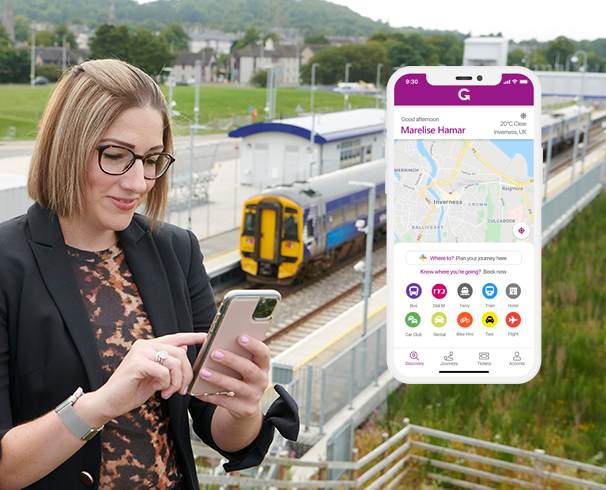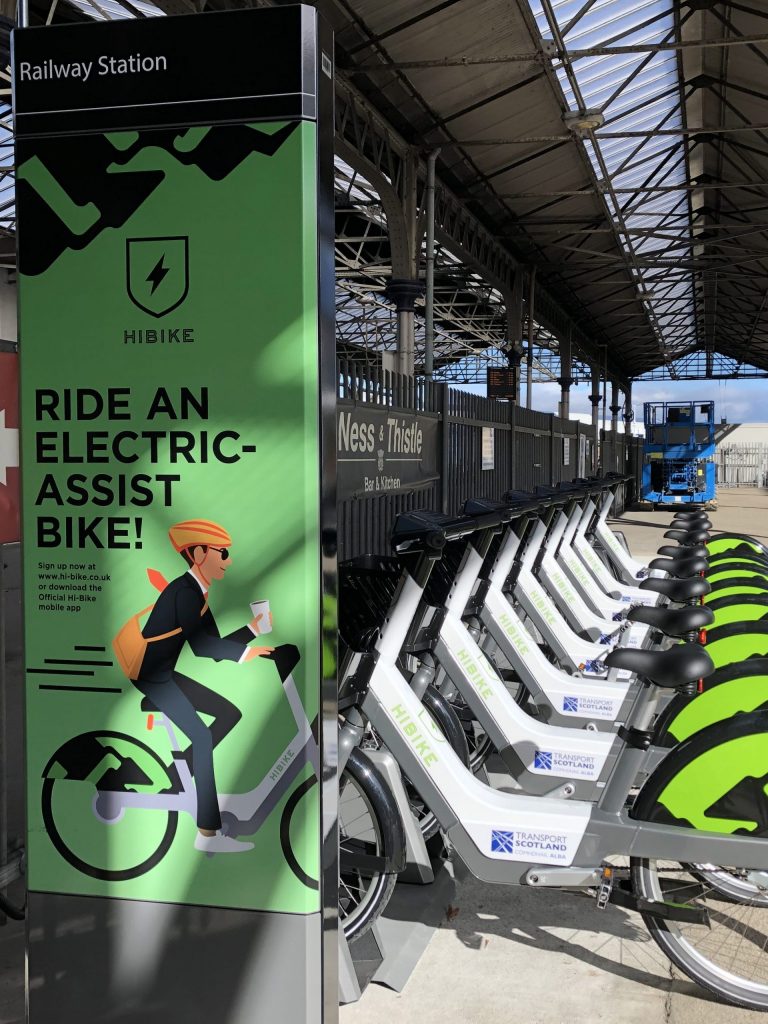
Travelling across rural Scotland can be challenging without a private car, especially if people are heading to unfamiliar places and uncertain about the public transport options available to them.
But a new smartphone app designed to present users with a host of sustainable and active travel choices tailored for their journey – plus the ability to book services – is proving its worth to those in the know across the Highlands & Islands.
The app is called Go-Hi and has been developed by regional transport partnership Hitrans and technology platform Mobilleo, with support from stakeholders including consultant Arcadis and the Cairngorms National Park Authority.
It currently has around 1500 active users and the hope is to grow this number to 5000 within the next 12 months.

Transport options covered by the platform include hiring an electric bicycle, renting a car and booking a car club vehicle as well as travelling by bus, train, taxi, aeroplane or ferry. Hotel stays can also be reserved through the app. Car sharing between drivers and those looking for a lift is not currently offered as part of the app, but may be in future.
A passenger uses the Go-Hi app on her phone
Participants in the scheme include Stagecoach (bus), Scotrail (trains), Enterprise (car hire), Brompton (bike hire), Easyjet and Northlink Ferries.
The platform has been developed to encourage people to try alternative modes of travel to a private vehicle in order to cut overall miles driven and improve the environment.
Giving people timely and useful information about travel options using mobile technology is often described in professional circles as an example of ‘Mobility as a Service’. The concept is more often associated with urban areas, with recent schemes including pilots in the West Midlands, Amsterdam and Helsinki.
But this latest project in the Highlands & Islands is thought to be one of the first for a rural setting, and covers a much larger geographical area than previous Mobility as a Service schemes.
Offering alternatives to car travel
“We definitely need to change our relationship with the car and to do that we need to give people proper alternatives to the car,” says Hitrans partnership director Ranald Robertson. He explains that Mobility as a Service apps like Go-Hi are an important tool in making people aware of different travel options available.

Getting about the Highlands & Islands region can be challenging by public transport, he continues, but a lack of travel information can be a problem as well. “Services may already exist, but people don’t use them because they are not aware of them,” he explains.
Bringing together several transport modes in one app should, he adds, make it easier for people to access services and plan journeys across the region.
Scotland has a strong ambition to reduce car use, Ranald says, and its national transport strategy “sets the right tone” by planning to reduce the number of vehicle kilometres driven by a fifth by 2030.
“If we are going to get there then people are going to have to travel less – such as through home working – but there needs to be a willingness too to invest in public transport.”
As well as allowing people to plan and pay for services, travel data collected by the app makes it easier for the authority to identify gaps in service provision.

For trips that are not possible by public transport, access to a car club helps to bridge that gap. And in due course, existing on-demand transport services are set to be moved onto the platform too. In future, a reward scheme may also be introduced for booking travel through the Go-Hi app.
Funding for the app was secured from Transport Scotland through its MaaS Investment Fund in late 2019, with support from the EU’s North Sea Region ‘Stronger Combined’ project. But launch of the service was delayed twice due to Covid and it went live in June 2021.
Around £880,000 has been provided by the Scottish Government in two tranches of funding, with investment also coming from Hitrans, typically to deliver new transport services such as e-bike docking stations.
Rural vision of integrated mobility
Arcadis transport innovation director Tim Strong says that Mobility as a Service has been demonstrated in several dense urban environments. But, he adds: “The complexities and challenges we are trying to address in this beautiful, vast and sometimes unpopulated region is what makes this project so exciting.”

Tim’s employer was involved in early workshops with Hitrans to help develop the concept and scope of the project, as well as the funding application. Going forward Arcadis is monitoring and evaluating the scheme, as is the University of Leeds.
“We are trying something new, innovative and exciting so we have to pay attention to what happens.
“I’m excited by the vision of this seamless system of integrated transport that works for people, is affordable, is as low carbon as possible and as kind to the environment as possible,” he adds.
Tim compares the MaaS project to the world of driverless vehicles, where “the end state is compelling and the journey is uncertain”. But, he adds, “the project is such a fantastic first step in the right direction”.
Cairngorms: an early adopter
One large land area in the Highlands which is heavily involved in the Go-Hi project is the Cairngorms, whose recent transport efforts include improving cycling infrastructure alongside Sustrans Scotland and introducing electric bikes for visitors to use.
It is now planning a network of e-bikes as part of a programme called ‘Heritage Horizons’, designed to reduce carbon emissions and encourage people to get more physically active.

David Clyne from the Cairngorms National Park Authority says: “I’m interested in the MaaS project both professionally and personally as I live and work in Aviemore and understand the difficulties of moving around rural Scotland.
Like many people, he says he is very aware of the transport options available in his area but not always so certain of the facilities available elsewhere.
“With the app, you tap in where you are and where you want to go and that harvests all available data and gives you the options for getting there,” he explains.
So, for instance, the app will highlight if there is an e-bike rental point nearby, or a car club pick up location, and if trains are available. “It does the hard work for you.”
David moved to Aviemore in the National Park in 2014 and was previously part of a two car household. He says public transport locally is not great, can be expensive and is not that reliable, particularly in winter.
During lockdown David decided to sell both his cars and bought an e-bike, which he now uses to get to work – 15 miles away. “An e-bike makes that sort of distance do-able and completely changed my view of active travel. I’m saving a lot of money by not having two cars.”

For longer journeys that cannot be made by public transport, David makes use of a car club in Aviemore, which has two vehicles that can be booked on the Go-Hi app.
For the National Park, he says there is an “amazing opportunity” using the app to help influence how some of its two million annual visitors travel there.
Once they have arrived, the hope is more of them will be able to use the platform to “move around in an active and sustainable manner, which not only makes them healthier and happier but also reduces the carbon impact of tourism.
“If we get the infrastructure right and have the platform for choosing which mode they want to use,” David says, “once they leave they can take that experience away and be catalysts for change at home.”
To find out more, visit gohi.app
Published on Transport Infrastructure News, 5 September 2022